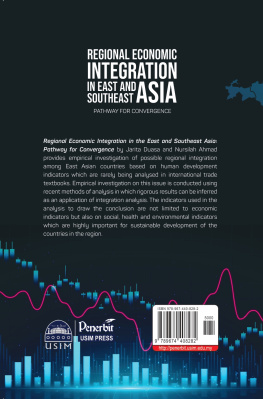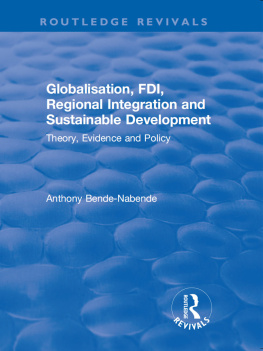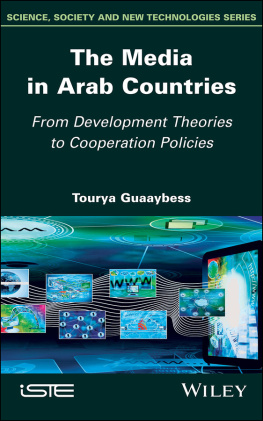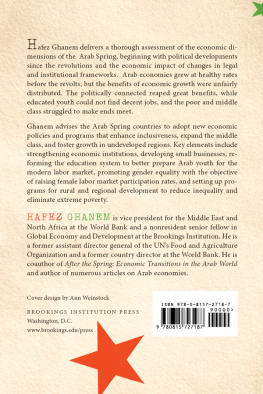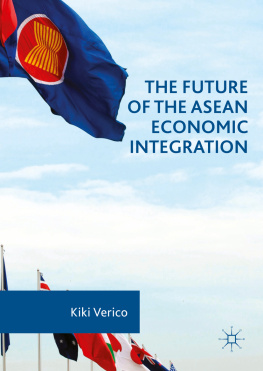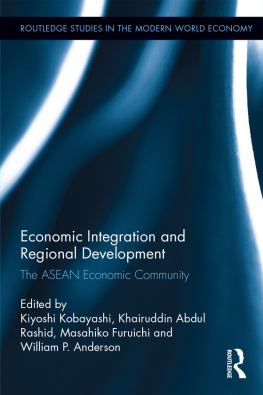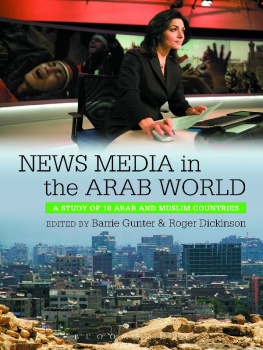ROUTLEDGE LIBRARY EDITIONS: THE ECONOMY OF THE MIDDLE EAST
Volume 3
ARAB INDUSTRIAL INTEGRATION
ARAB INDUSTRIAL INTEGRATION
A Strategy for Development
ELIAS T. GHANTUS
First published in 1982
This edition first published in 2015
by Routledge
2 Park Square, Milton Park, Abingdon, Oxon, OX14 4RN
and by Routledge
52 Vanderbilt Avenue, New York, NY 10017
Routledge is an imprint of the Taylor & Francis Group, an informa business
1982 Elias T. Ghantus
All rights reserved. No part of this book may be reprinted or reproduced or utilised in any form or by any electronic, mechanical, or other means, now known or hereafter invented, including photocopying and recording, or in any information storage or retrieval system, without permission in writing from the publishers.
Trademark notice: Product or corporate names may be trademarks or registered trademarks, and are used only for identification and explanation without intent to infringe.
British Library Cataloguing in Publication Data
A catalogue record for this book is available from the British Library
ISBN: 978-1-138-78710-0(Set)
ISBN: 978-1-138-81047-1 (Volume 3)
Publishers Note
The publisher has gone to great lengths to ensure the quality of this reprint but points out that some imperfections in the original copies may be apparent.
Disclaimer
The publisher has made every effort to trace copyright holders and would welcome correspondence from those they have been unable to trace.
ARAB INDUSTRIAL INTEGRATION
A STRATEGY FOR DEVELOPMENT
Elias T.
Ghantus
Elias T. Ghantus
Croom Helm Ltd, 2-10 St Johns Road, London SW11
British Library Cataloguing in Publication Data
Ghantus, Elias T.
Arab industrial integration.
1. Arab countries Economic integration
I. Title
338.9009174927 HC498
ISBN 0-7099-1117-3
Printed and bound in Great Britain by
Biddles Ltd, Guildford and Kings Lynn
CONTENTS
This work is a result of over two decades of personal involvement in regional economic co-operation and integration in the Arab Middle East. My work since 1961 with the General Union of Chambers of Commerce, Industry and Agriculture for Arab Countries, where I now serve as Assistant Secretary General, put me in direct contact with regional economic developments. It gave me the opportunity of attending frequently the meetings of the Arab Economic Council of the League of Arab States and of the Arab Economic Unity Council. On another level, my association with the Department of Economics at the American University of Beirut since 1975, as a Lecturer on Middle East Economics, has been very useful in stimulating my thinking about the possibilities for economic integration in the region.
What always struck me at the inter-governmental Arab economic meetings is the emphasis on trade liberalisation as a means for economic integration, though in more recent years different approaches have been considered. The Arab countries were treated as if they belonged to the same economic category, with no sufficient regard being given to the differences in their levels of economic development, economic size, or development strategy. My contention is that a more realistic, practical and gradual approach for integration is required: one which would take into consideration the differing economic settings of the individual Arab countries. It is the purpose of this study to seek such an approach based on a strategy for integrated industrial development among the Arab countries.
The study comprises two parts. In a discussion of alternative approaches to regional industrial integration is presented, with a view to appraising the package deal approach as an innovative solution to the problem of distribution of benefits and costs.
In presents an epilogue.
An earlier version of this study was submitted as my doctoral dissertation at the University of Durham, and I wish to record my deep gratitude to Dr R.J.A. Wilson for his sharp criticism and advice in its preparation. I also benefited from the sympathetic criticism of Professor Denis P. OBrien who kindly took the time to read the whole dissertation.
My thanks are due to Professor Burhan Dajani, presently Secretary General of the Union of Arab Chambers, who constantly encouraged me to undertake this work. He has always been to me a source of inspiration for academic writing and intellectual thinking. At the American University of Beirut, I have benefited from discussions with Professor Samir A. Makdisi. I also wish to record my indebtedness to many officials and specialists in the League of Arab States and the Council of Arab Economic Unity, as well as in other Arab economic organisations, ECWA, UNCTAD, UNIDO and OECD, who gave me much of their time and attention to discuss various aspects of this study and to obtain numerous useful documents on the subject. Unfortunately, they are too many to be listed here. However, I alone bear the responsibility for any flaws which may still remain.
Last, but not least, many thanks go to my wife, Leila, who enabled me to have the time and peace of mind to complete the writing of this study, by shouldering the full burden of looking after our daughters, Maha, Mona, Najwa and Nada.
Elias T. Ghantus
Beirut
ACM Arab Common Market
AEC Arab Economic Council
AFESD Arab Fund for Economic and Social Development
AS Ammonium sulphate
ASEAN Association of South-East Asian Nations
ASMO Arab Specifications and Metrology Organisation
BD Bahraini Dinar
CACM Central American Common Market
CAEU Council of Arab Economic Unity
DAP Diammonium phosphate
Dh UAE Dirham
ECAFE Economic Commission for Asia and the Far East
ECLA Economic Commission for Latin America
ECWA Economic Commission for Western Asia
EEC European Economic Community
FAO Food and Agriculture Organisation of the United Nations
GATT General Agreement on Tariffs and Trade
GDP Gross domestic product
GNP Gross national product
HDPE High density polyethylene
IAIGC Inter-Arab Investment Guarantee Corporation
IDCAS Industrial Development Centre for Arab States
ID Iraqi Dinar
JD Jordanian Dinar
KD Kuwaiti Dinar
KFAED Kuwait Fund for Arab Economic Development
LDPE Low density polyethylene
MAP Monoammonium phosphate
m.e.s. Minimum-efficient-scale
NGL Liquefied natural gas
OAPEC Organisation for Arab Petroleum Exporting Countries
SABIC Saudi Basic Industries Corporation
SSP Single superphosphate
SRI Saudi Riyal
TSP Triple superphosphate
UAE United Arab Emirates
UNCTAD United Nations Conference on Trade and Development
UNESOB United Nations Economic and Social Office in Beirut
UNIDO United Nations Industrial Development Organisation



